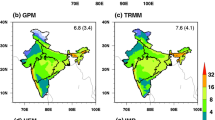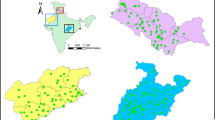Abstract
India Meteorological department (IMD) used INSAT-3D Metrological Satellite Imager data to drive two type rainfall estimation products viz-Hydro Estimate (HE) and INSAT Multi-Spectral Rainfall Algorithm (IMSRA) on half hourly rainfall rate and daily accumulated rainfall in millimeter (mm). Integrated Multi-Satellite Retrieval for GPM (IMERG) product is being derived by NASA and JAXA by using Global Precipitation Mission (GPM) satellites data. IMSRA and GPM (IMERG) are gridded data at 10 km spatial resolution and HE is available at pixel level (4 km at Nadir). IMD provides gridded rainfall data at 0.25° × 0.25° resolution which is based on wide coverage of 6955 actual observation. In present study, validation of INSAT-3D based Hydro Estimator (HE), INSAT Multi-Spectral Rainfall Algorithm (IMSRA) and Integrated Multi-Satellite Retrieval for GPM (IMERG) of Global Precipitation Mission (GPM) satellites are carried out with IMD gridded data set for heavy rainfall event during winter monsoon, over peninsular India (November–December 2015). In validation, Nash–Sutcliffe efficiencies (NSE), RMSE, Correlation, Skilled scores are calculated at grid level for heavy and very heavy rain categories and the values of NSE of HE (− 32.36, − 3.12), GPM (− 68.67, − 2.39) and IMSRA (− 0.02, 0.28) on 16th November 2015 and HE (− 13.65, − 1.69), GPM (− 43.79, − 2.94) and IMSRA (− 1.08, − 1.60) on 2nd Dec 2015, for heavy and very heavy rainfall. On both days, HE is showing better rainfall estimate compare to GPM for Heavy rainfall and GPM showing better estimation for very heavy rainfall events. In all the cases IMSRA is underestimating, if daily rain fall exceeded 75 mm.




Similar content being viewed by others
References
Adler, R. F., Huffman, G. J., Bolvin, D. T., Curtis, S., & Nelkin, E. J. (2000). Tropical rainfall distributions determined using TRMM combined with other satellite and rain gauge information. Journal of Applied Meteorology, 39, 2007–2023.
Adler, R. F., Negri, A. J., Keehn, P. R., & Hakkarinen, I. M. (1993). Estimation of monthly rainfall over Japan and surrounding waters from a combination of low-orbit microwave and geosynchronous IR data. Journal of Applied Meteorology, 32, 335–356.
Arkin, P. A., & Meisner, B. N. (1987). The Relationship between Large-Scale Convective Rainfall and Cold Cloud over the Western-Hemisphere during 1982–84. Monthly Weather Review, 115, 51–74.
Barrett, E. C., & Martin, D. W. (1981). The use of satellite data in rainfall monitoring. London: Academic Press.
Bhandari, S. M., & Varma, A. K. (1995). Estimation of large scale monthly rainfall over Indian region using minimal INSAT-VHRR data. International Journal of Remote Sensing, 16(11), 2023–2030.
Bharti, V., & Singh, C. (2015). Evaluation of error in TRMM 3B42V7 precipitation estimates over the Himalayan region. Journal of Geophysical Research: Atmospheres, 120, 12458–12473. https://doi.org/10.1002/2015jd023779.
Bharti, V., Singh, C., Ettema, J., & Turkington, T. A. R. (2016). spatiotemporal characteristics of extreme rainfall events over the Northwest Himalaya using satellite data. International Journal of Climatology, 36, 3949–3962. https://doi.org/10.1002/joc.4605.
Charlotte, B. V., Simon, E. K., George, G., Yesodharan, S., & Ruchith, R. D. (2012). Intra-seasonal oscillation of north east monsoon over southern peninsular India-an investigation. International Journal of Scientific and Research Publications, 2, 1–22.
Doswell, C. A., Davies-Jones, R., & Keller, D. L. (1990). On summary measures of skill in rare event forecasting based on contingency tables. Weather Forecast, 5, 576–585.
Gairola, R. M., Varma, A. K., & Agarwal, Vijay K. (2003). Rainfall estimation using space borne microwave radar and radiometric measurements. Mausam, 54(1), 89–106.
Goswami, B. N., Venugopal, V., Sengupta, D., Madhusoodanan, M. S., & Xavier, P. K. (2006). Increasing trend of extreme rain events over India in a warming environment. Science, 314, 1442–1445.
Gupta, A. K., & Nair, S. S. (2011). Urban floods in Bangalore and Chennai: Risk management challenges and lessons for sustainable urban ecology. Current Science, 100, 1638–1645.
Haile, A. T., Rientjes, T. H., Gieske, A., & Gebremichael, M. (2010). Rainfall estimation at the source of the Blue Nile: A multispectral remote sensing approach. International Journal of Applied Earth Observation and Geoinformation, 12, S76–S83. https://doi.org/10.1016/j.jag.2009.09.001.
Hariprasad, K. B. R. R., Srinivas, C. V., Singh, A. B., Vijaya Bhaskara Rao, S., Baskaran, R., & Venkatraman, B. (2014). Numerical simulation and intercomparison of boundary layer structure with different PBL schemes in WRF using experimental observations at a tropical site. Atmospheric Research, 145–146, 27–44. https://doi.org/10.1016/j.atmosres.2014.03.023.
Joerin, J., Shaw, R., Takeuchi, Y., & Krishnamurthy, R. (2012). Assessing community resilience to climate-related disasters in Chennai, India. Journal of Disaster Risk Reduction, 1, 44–54. https://doi.org/10.1016/j.ijdrr.2012.05.006.
Joyce, R., Janowiak, J. E., Arkin, P. A., & Xie, P. (2004). CMORPH: A method that produces global precipitation estimates from passive microwave and infrared data at high spatial and temporal resolution. Journal of Hydrometeorology, 5, 487–503.
Krishnamurthy, R., & Desouza, K. C. (2015). Chennai, India. Cities, 42, 118–129. https://doi.org/10.1016/j.cities.2014.09.004.
Kumar, O. S. R. U. B., Naidu, C. V., Rao, S. R. L., & Rao, B. R. S. (2004). Prediction of southern Indian winter monsoon rainfall from September local upper-air temperatures. Meteorological Applications, 199, 189–199. https://doi.org/10.1017/s1350482704001306.
Le Marshall, J., Leslie, L., Morison, R., Pescod, N., Seecamp, R., & Spinoso, C. (2000). Recent developments in the continuous assimilation of satellite wind data for tropical cyclone track forecasting. Advances in Space Research, 25, 1077–1080. https://doi.org/10.1016/s0273-1177(99)00445-7.
Leslie, L., LeMarshall, J. F., Morison, R. P., Spinoso, C., Purser, R. J., Pescod, N., et al. (1998). Improved hurricane track forecasting from the continuous assimilation of high quality satellite wind data. Monthly Weather Review, 126, 1248–1257.
Mallett, J. D., & Brennan, L. E. (1963). Cumulative probability of detection for targets approaching a uniformly scanning search radar. Proceedings of the IRE, 51, 596–601.
Mishra, A., Gairola, R. M., Varma, A. K., & Agarwal, V. K. (2009). Study of intense rainfall events over India using Kalpana-IR and TRMM precipitation radar observations. International Journal of Current Science, 97, 689–695.
Mishra, A., Gairola, R. M., Varma, A. K., & Agarwal, V. K. (2010). Remote sensing of precipitation over Indian land and oceanic regions by synergistic use of multi-satellite sensors. Journal Geophysical Research, 115, D08106. https://doi.org/10.1029/2009jd012157.
Nash and Sutcliffe. (1970). J.E. Nash, J.V. Sutcliffe River flow forecasting through conceptual models part I—A discussion of principles. Journal of Hydrology, 10, 282–290. https://doi.org/10.1016/0022-1694(70)90255-6.
Pai, D. S., et al. (2014). Development of a very high spatial resolution (0.250 × 0.250) Long period (1901–2010) daily gridded rainfall data set over the Indian region. Mausam, 65(1), 1–18.
Pattanaik, D. R., & Rajeevan, M. (2010). Variability of extreme rainfall events over India during southwest monsoon season. Meteorological Applications, 17(1), 88–104.
Prakash, S., Sathiyamoorthy, V., Mahesh, C., & Gairola, R. M. (2014). An evaluation of high-resolution multisatellite rainfall products over the Indian monsoon region. International Journal of Remote Sensing, 35(9), 3018–3035.
Rajeevan, M., Bhate, J., & Jaswal, A. K. (2008). Analysis of variability and trends of extreme rainfall events over India using 104 years of gridded daily rainfall data. Geophysical Reseach Letters, 35, L18707. https://doi.org/10.1029/2008gl035143.
Roca, R., Viollier, M., Picon, L., & Desbois, M. (2002). A multi satellite analysis of deep convection and its moist environment over the Indian Ocean during the winter monsoon. Journal of Geophysical Reseach, 107(D19), 8012. https://doi.org/10.1029/2000JD000040.
Sateesh, M., Raju, P. V. S., & Hazards, N. (2017). Numerical simulation of tropical cyclone thane: role of boundary layer and surface drag parameterization schemes. Natural Hazards, 20, 11–12. https://doi.org/10.1007/s11069-017-3020-2.
Schaefer, J. T. (1990). The critical success index as an indicator of warning skill. Weather Forecast, 5, 570–575.
Srinivasan, V., Seto, K. C., Emerson, R., & Gorelick, S. M. (2013). The impact of urbanization on water vulnerability: A coupled human–environment system approach for Chennai, India. Global Environmental Change, 23, 229–239. https://doi.org/10.1016/j.gloenvcha.2012.10.002.
Stephenson, D. B. (2000). Use of the “odds ratio” for diagnosing forecast skill. Weather Forecast, 15, 221–232.
Tawde, S. A., & Singh, C. (2015). Investigation of orographic features influencing spatial distribution of rainfall over the Western Ghats of India using satellite data. International Journal of Climatology, 35, 2280–2293. https://doi.org/10.1002/joc.4146.
Todd, M. C., Kidd, C., Kniveton, D., & Bellerby, T. J. (2001). A combined satellite infrared and passive microwave technique for estimation of small-scale rainfall. Journal of Atmospheric and Oceanic Technology, 18, 742–755.
Varma, Atul K., & Liu, Guosheng. (2006). Small-scale horizontal rain-rate variability observed by satellite. Monthly Weather Review, 134(10), 2722–2733.
Varma, Atul Kumar, & Liu, Guosheng. (2010). on classifying rain types using satellite microwave observations. Journal of Geophysical Research, Atmospheres, 115, D7.
Varma, A. K., & Pal, P. K. (2012). Use of TRMM precipitation radar to address the problem of rain detection in passive microwave measurements. Indian Journal of Radio & Space Physics, 41, 411–420.
Varma, A. K., Pokhrel, S., Gairola, R. M., & Agarwal, V. K. (2003). An empirical algorithm for cloud liquid water from MSMR and its utilization in rain identification. IEEE Transactions on Geoscience and Remote Sensing, 41, 1853–1858.
Zhihua, Z., Yihong, D., Xudong, L., Leiming, M., & Chan, J. C. (2005). The effect of three-dimensional variational data assimilation of QuikSCAT data on the numerical simulation of typhoon track and intensity. Advances in Atmospheric Sciences, 22, 534–544.
Acknowledgements
We thankful to DGM of India Meteorological Department for carrying this research work,and We also thankful to Global Precipitation Mission for providing the real time global data.
Author information
Authors and Affiliations
Corresponding author
About this article
Cite this article
Singh, A.K., Singh, V., Singh, K.K. et al. A Case Study: Heavy Rainfall Event Comparison Between Daily Satellite Rainfall Estimation Products with IMD Gridded Rainfall Over Peninsular India During 2015 Winter Monsoon. J Indian Soc Remote Sens 46, 927–935 (2018). https://doi.org/10.1007/s12524-018-0751-9
Received:
Accepted:
Published:
Issue Date:
DOI: https://doi.org/10.1007/s12524-018-0751-9




